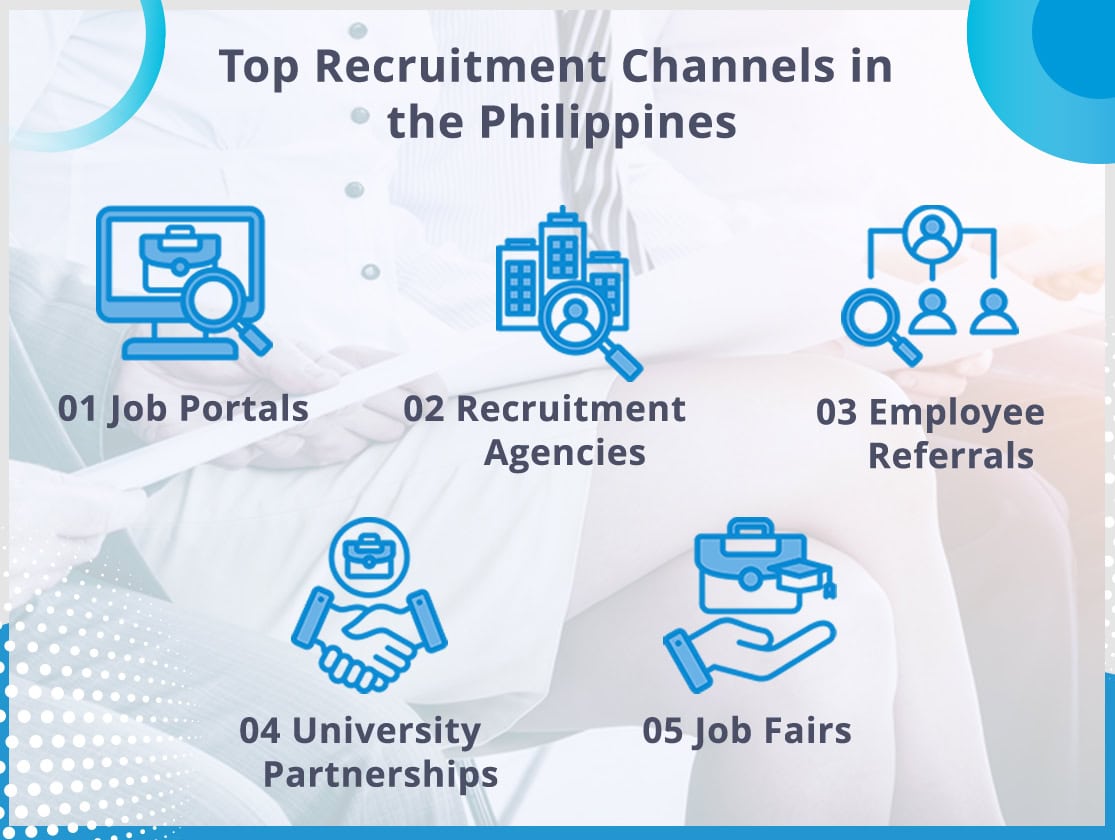Actionable Guides and Tips for Successful
Offshoring to The Philippines
Effective Strategies for Recruiting Top Talent in the Philippines

The Philippines, especially in the business process outsourcing (BPO) industry, has cemented its standing as one of the world’s top destinations for offshore talent sourcing. This achievement is currently being duplicated in the knowledge process outsourcing (KPO) sector. Filipino professionals are showing that they are adept at managing challenging projects that call for consultant-level knowledge and working with a range of industries. Given that the Philippines provides both BPO and KPO services, it is not surprising that the country has between 10%-15% of the world’s outsourcing industry.
A home to more than 109 million people, the Philippines, has a youthful and dynamic population that continuously provides a steady supply of skilled offshore talent. According to estimates from the Philippine Statistics Authority (PSA), the country’s educational system produces 1.5 million high school graduates and around 500,000 college graduates annually. Numerous offshoring businesses in various industries, like digital marketing, IT and web development, engineering and architecture, accounting, real estate, and even medical health, have been leveraging these young Filipino experts to achieve success in their offshoring journey.
Explore some of the most effective strategies for recruiting top talent in your offshoring in the Philippines journey for your business. Understand the Filipino workforce, leverage effective recruitment channels, and strategically utilise social media for talent acquisition.
Understanding the Filipino Workforce

The key to a successful hiring process is knowing the local labour market. Global businesses find Filipinos to be an attractive talent pool because of their reputation for resilience, adaptability, and cultural congruence with Western business methods.
Cultural Traits and Work Ethics
Strong family values are a defining feature of Filipino society, and these beliefs inevitably lead to high levels of devotion and loyalty at work. The idea of “Bayanihan,” or the spirit of community harmony and cooperation, serves as further support for this emphasis on solid connections. This translates into a cooperative workforce in a business context that values cooperation and has a strong sense of accountability for accomplishing organisational goals.
It’s also critical to understand that when working with a Filipino team, they can come from a “YES” culture, usually this happens when the environment they worked in previously had a lack of safety to voice alternate ideas and or opposing opinions. So at the early stage, when interviewing them, be mindful to ask for their opinion and set the stage for them to be open and comfortable so you have the best conversation possible. Creating an atmosphere that promotes candid communication and gives Filipino employees the freedom to share their viewpoints is a must because it will eventually help your offshore business achieve success.
Educational Background and Skills
The Philippines boasts an exceptionally high literacy rate of 98.5% (UNESCO), making the country a leader in Southeast Asia in terms of literacy rate. Similarly, Philippine Statistics Authority data from 2020 reveals that over 23% of college graduates possess business, management, and economics degrees, with information technology (IT) following closely at 13.7%. Notably, graduates with specialised qualifications in web development, data analysis, and artificial intelligence are becoming increasingly common. This trend aligns perfectly with the growing demand from BPO companies seeking to expand their service offerings.
Language Proficiency
Filipinos stand out for their exceptional multilingual skills. EF Education First’s 2021 survey ranked the Philippines second globally (behind Singapore only) in English proficiency, scoring 67.28. This fluency makes Filipino talent highly desirable for BPO companies serving international clients, especially when it comes to being ready for fast onboarding processes that require training.
Top Recruitment Channels in the Philippines

Identifying and utilising the right recruitment channels is crucial for attracting and securing top Filipino offshore talent for your outsourcing in the Philippines. The following channels have proven effective in the Philippine job market.

Job Portals
Online job boards remain a cornerstone of effective recruitment in the Philippines. Platforms like JobStreet, Kalibrr, and Indeed boast extensive databases of job seekers and offer robust filtering and shortlisting tools based on your specific requirements. These portals streamline the process by allowing recruiters to post job advertisements and receive applications directly within the platform.
While these platforms have been popular and familiar to most businesses, there’s a growing trend towards niche online job platforms that cater to specific industries and skill sets. Explore platforms like PhilDev for IT professionals, Upwork for freelancers, and Rakuten Viber Jobs for opportunities within the Viber ecosystem. These targeted platforms allow you to reach a concentrated pool of highly qualified candidates actively seeking new opportunities within your industry.

Recruitment Agencies
Leveraging recruitment agencies can significantly enhance your hiring process in the Philippines. These agencies possess extensive networks and a deep understanding of the local talent pool that can help you with staff leasing or any hiring and employment method your prefer. They offer access to pre-vetted candidates and provide comprehensive support throughout the recruitment journey, from initial outreach to successful placement.
Look for recruitment agencies that can also understand your business to find the right offshore talent for your needs. Some offshoring providers in the Philippines can help you with not just recruitment but also supporting you in managing your dedicated offshore team.

Employee Referrals
Employee referral programmes are a strategic recruitment tool that capitalises on the existing employee network to source potential talent. This approach frequently yields high-calibre hires because current employees are more likely to recommend individuals who align well with the company culture and possess the required skills. To incentivize participation, companies offer attractive bonuses or other rewards to employees whose referrals lead to successful placements.
Several companies have successfully implemented employee referral programmes, demonstrating their effectiveness:
- Google: Google’s employee referral programme is renowned for its success. The company offers substantial bonuses for successful referrals and has a streamlined referral process. Google’s programme has been instrumental in hiring top talent, with referrals accounting for a significant portion of their hires.
- Ernst & Young (EY): EY’s referral programme, “Refer for Success,” incentivizes employees with bonuses and recognition. The programme led to a 45% referral rate for experienced hires, showcasing its effectiveness in attracting high-quality candidates.
- Deloitte: Deloitte’s employee referral programme is a key component of their recruitment strategy. The company offers competitive referral bonuses and emphasises the importance of referrals in their hiring process. Deloitte’s programme has contributed to a high rate of successful hires and improved employee retention.

Job Fairs
Job fairs remain a powerful recruitment tool, offering companies a platform to connect with a significant pool of potential hires within a compressed timeframe. These events, often organised by industry associations, universities, or government entities, allow companies to effectively showcase their employer brand and attract a diverse pool of qualified candidates.
These are some of the types of Job Fairs:
- University-Sponsored Job Fairs: Universities regularly organise job fairs to connect students with potential employers. For example, the University of Santo Tomas (UST) hosts an annual job fair attended by hundreds of companies and thousands of students.
- Industry-Specific Job Fairs: Industry associations often organise job fairs focused on specific sectors, such as IT, healthcare, or engineering. The IT and Business Process Association of the Philippines (IBPAP) organises events targeting the BPO sector, attracting relevant candidates.
- Government-Sponsored Job Fairs: The Philippine Overseas Employment Administration (POEA) and the Department of Labour and Employment (DOLE) sponsor job fairs to help reduce unemployment and match job seekers with employers. These fairs provide a platform for both local and overseas employment opportunities.
Leveraging Social Media for Talent Acquisition

Social networking platforms have become a very effective tool for hiring. Social media sites like Facebook, Twitter, and LinkedIn provide special chances to interact with possible applicants and advertise job openings.
LinkedIn is the most popular professional networking site in the Philippines, with an astounding 7.9 million Filipino users. The platform is useful for recruiting because of its various features:
- Advanced Search Filters: Using sophisticated search filters, recruiters may focus on applicants that meet certain requirements like geography, industry, experience level, and skill set. This accuracy facilitates the speedy identification of the best prospects.
- InMail Messaging: Recruiters may reach out to prospective applicants directly using InMail Messaging, even if they are not linked. Candidates’ engagement and response rates to personalised InMail communications can rise.
- Candidate Insights: LinkedIn Recruiter offers insightful data on applicant behaviour, including their platform usage, which may assist recruiters in determining how receptive and interested a prospect is.
- Project Management: Recruiters may handle several job postings and follow the development of diverse candidates more easily by grouping candidates into projects.
- Team Collaboration: Using LinkedIn Recruiter, team members can work together on candidate searches, exchange notes, and plan actions, which increases productivity and efficacy all around.

Facebook’s massive user base in the Philippines, exceeding 76 million, makes it a powerhouse for reaching a broad spectrum of potential hires. Companies can leverage this platform by creating dedicated career pages, strategically posting job openings, and fostering engagement through regular updates and interactive content.
Facebook’s sophisticated targeting capabilities empower companies to ensure their job advertisements reach the most relevant candidates by pinpointing specific demographics and geographic locations.
Features and Benefits of Using Facebook for Recruitment:
- Targeted Advertising: Facebook’s advanced targeting options allow companies to reach specific audiences based on criteria such as location, age, education level, job titles, and interests. This ensures that job ads are seen by the most relevant candidates.
- Engagement and Interaction: Facebook enables companies to engage with potential candidates through comments, messages, and interactive content. This fosters a sense of community and allows for real-time interaction and feedback.
- Facebook Jobs: The Facebook Jobs feature allows companies to post job openings directly on their page, making it easy for users to apply through the platform. This feature simplifies the application process and increases the visibility of job postings.
Insightful Analytics: Facebook provides detailed analytics on the performance of job ads and posts, helping companies refine their strategies and improve their recruitment efforts.

With millions of active users, Twitter has a substantial following in the Philippines despite not being the most popular medium for job seekers like Facebook or LinkedIn (Statista, 2023). This platform offers a great chance to broaden your audience and interact with possible employees. Businesses may use Twitter to disseminate corporate news, advertise job vacancies, and position themselves as authorities in their field. Employing pertinent hashtags such as #JobOpening or #Hiring will greatly boost the exposure of your job listings and draw in top candidates.
Features and Benefits of Using Twitter for Recruitment
- Real-Time Updates: Businesses can instantly communicate job opportunities, corporate news, and industry insights on Twitter thanks to its real-time nature, which keeps their audience informed and interested.
- Hashtags for Visibility: Utilising pertinent hashtags like #JobOpening, #Hiring, and #Careers can help job postings become more visible and reach a wider audience.
- Employee Advocacy: By encouraging staff members to post job opportunities and business news on their own Twitter accounts, employers may reach a wider audience throughout the hiring process and draw in top talent from employee networks.
- Networking Opportunities: Twitter is a great way to connect with business leaders in the field, take part in pertinent conversations, and find prospective employees who are involved in business-related activities.

Instagram has over 20 million users in the Philippines (DataReportal); it’s a gateway to a younger, visually oriented demographic. Companies seeking talent with strong creative abilities can leverage Instagram to showcase their company culture compellingly. Sharing employee achievements and behind-the-scenes glimpses fosters a sense of connection and attracts candidates who resonate with your brand’s values.
Features and Benefits of Using Instagram for Recruitment:
- Visual Storytelling: Instagram’s visual format makes it possible for businesses to use images and videos to create a story about their corporate values, workplace culture, and employee experiences. Candidates who connect with the company’s brand may be drawn in as a result.
- Instagram Stories: Businesses may utilise Instagram Stories to post staff takeovers, behind-the-scenes photos, and temporary updates. This feature offers a more genuine and intimate view of the business.
- IGTV and Reels: These platforms let businesses share innovative short-form content and longer films, respectively. Videos of everyday life, staff testimonials, and other interesting information may be shared using these tools.
Hashtags and Geotags: The use of pertinent hashtags and geotags can enhance a post’s exposure and connect it with job seekers who are looking for work in particular areas or sectors.

YouTube
With over 55 million users (We Are Social & Hootsuite), YouTube reigns supreme as the Philippines’ social media video platform. This dominance makes it an ideal platform to reach a vast audience of potential recruits. Companies can leverage YouTube’s reach by creating engaging video content specifically tailored for recruitment purposes. Showcase your company culture, offer insights into the hiring process, and feature real stories from current employees. This compelling video storytelling allows potential hires to connect with your brand and gain a deeper understanding of your work environment, fostering a sense of what it’s truly like to be part of your team.
Features and Benefits of Using YouTube for Recruitment:
- Engaging Video Content: Video is a highly engaging format that can effectively communicate the company’s culture, values, and job opportunities. Videos can include employee testimonials, office tours, and day-in-the-life segments.
- YouTube Channels: Creating a dedicated YouTube channel for recruitment allows companies to organise and showcase all their recruitment-related videos in one place. This makes it easy for potential candidates to find and watch relevant content.
- SEO and Discoverability: Optimising video titles, descriptions, and tags for search engines can increase the discoverability of recruitment videos, attracting a broader audience.
- Live Streaming: YouTube’s live streaming feature can be used for virtual job fairs, Q&A sessions, and live company events, providing real-time interaction with potential candidates.

Conclusion

To recruit top talent in the Philippines, a strong strategy is essential. First, companies must understand the local workforce and their career aspirations. Secondly, they should use a mix of recruitment channels, such as job fairs and social media, to reach potential candidates. Thirdly, creating a strong employer brand and offering competitive compensation packages are crucial for attracting and retaining top Filipino talent.
Using technology to streamline recruitment processes and showcase a positive work environment helps companies position themselves as employers of choice in the Philippines’ offshoring industry. This approach taps into a rich and diverse talent pool, providing a competitive edge for businesses globally.
The most efficient and cost-effective way to recruit top talent in the Philippines is to partner with an experienced offshoring provider. These providers possess the technical skills and local market knowledge necessary to find the best candidates. Research from the Philippines Institute for Development Studies (PIDS) indicates that companies partnering with experienced offshoring providers achieve better recruitment outcomes and access a wider range of talent.
Access unlimited roles in different industries that the Philippines can offer. Talk with Shore360 to learn more about how you can streamline your recruitment process.

